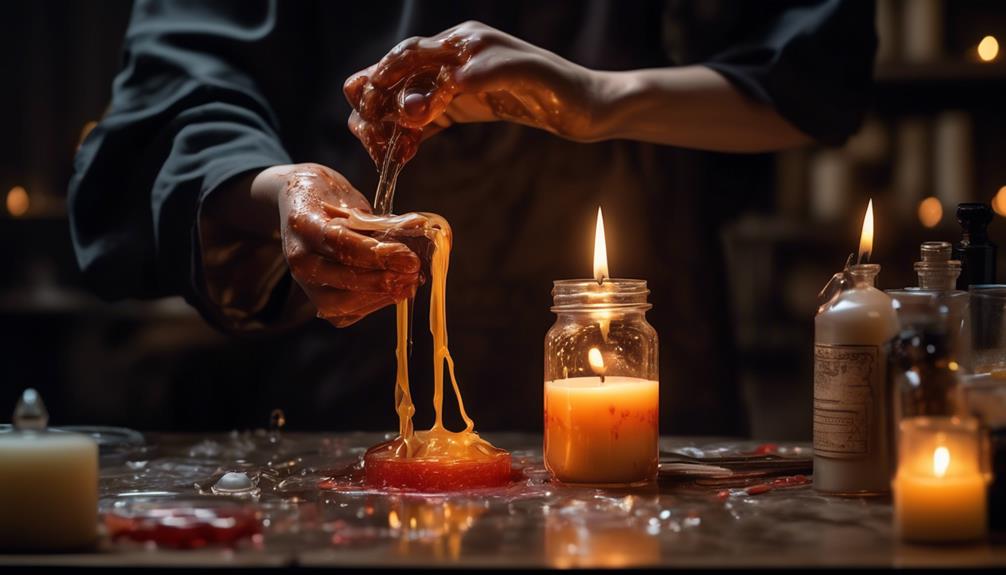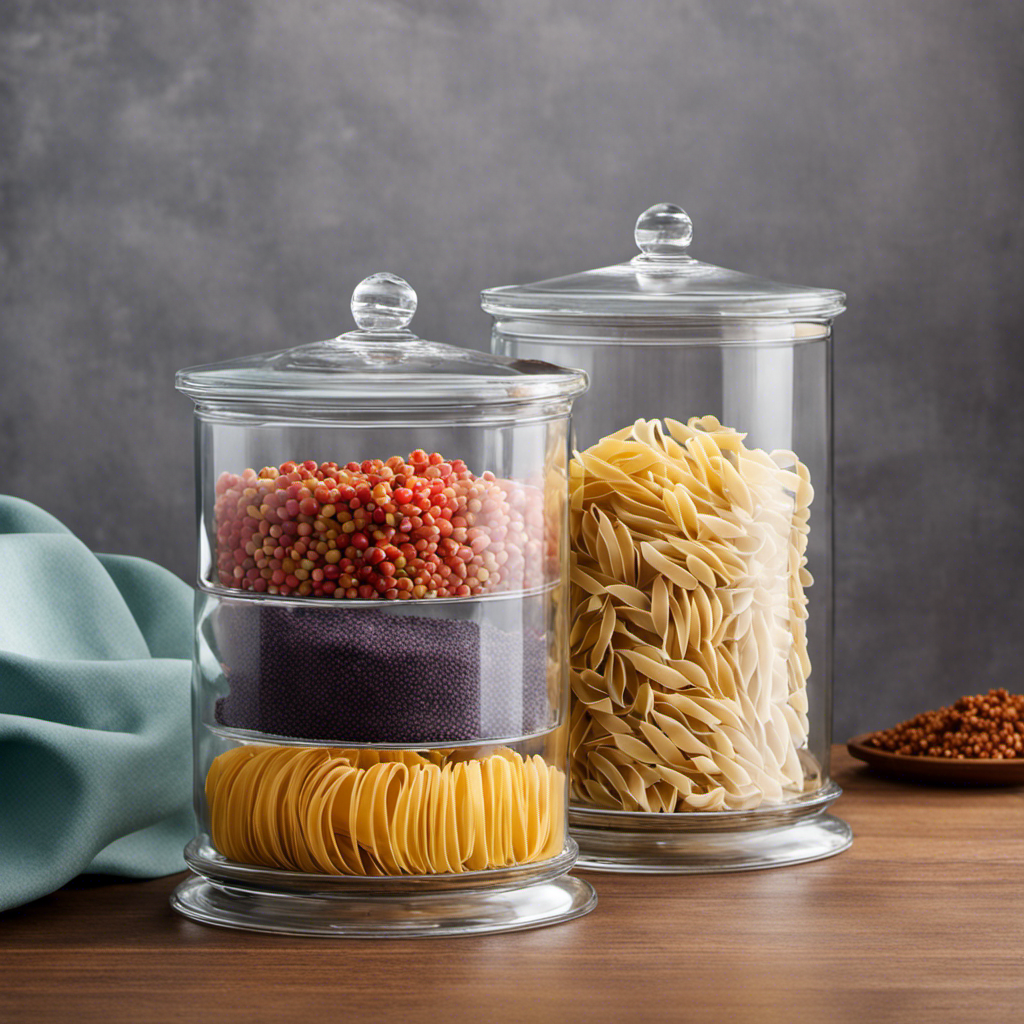Decor
How Do I Make Diy Candles?
2025

Venturing into the craft of DIY candle making might seem as daunting as finding your way through a thick forest without any direction. However, worry not, for we are here to lead you through every step of the journey.
From selecting the right materials to mastering the art of candle-making, there's a lot to cover.
So, grab your apron and get ready to embark on a journey that will fill your home with the warm glow of your very own handcrafted candles.
Key Takeaways
- Consider the melting temperature of the wax and choose the right type for your candle, such as soy wax for container candles and beeswax for pillars and votives.
- Select the appropriate wick based on burning characteristics, size, and desired burn time.
- Use essential oils for pleasant aromas and experiment with different scents.
- Ensure workspace safety by working in a well-ventilated area, using proper equipment, and following safety precautions.
Choosing the Right Candle Wax
When making DIY candles, it's essential to choose the right candle wax to ensure a successful and enjoyable candle-making experience. The melting temperature and fragrance options are crucial factors to consider when selecting the perfect wax for your candles.
Different waxes have varying melting points, affecting the candle's burning time and the scent throw. For instance, soy wax has a lower melting temperature, making it ideal for container candles, while beeswax has a higher melting point, suitable for pillars and votives.
Consider the fragrance options when choosing your candle wax. Some waxes are better at holding and releasing scents, enhancing the overall aromatic experience. Soy wax, for example, is known for its excellent scent throw, making it perfect for heavily scented candles. On the other hand, paraffin wax blends well with a variety of fragrances and provides a strong hot throw when the candle is lit.
Understanding the melting temperature and fragrance options of different waxes allows us to tailor our candle-making process to achieve the desired results. It's exciting to explore the diverse wax options and experiment with various fragrances to create unique, personalized candles.
Selecting the Ideal Candle Wicks

Selecting the ideal candle wicks is a crucial step in ensuring a clean, consistent burn for your DIY candles. When it comes to choosing the right wicks, there are a few key factors to consider:
- Wick types: There are various types of wicks available, including cotton, wood, and hemp. Each type has its own unique burning characteristics, so it's essential to select the one that best suits your candle's purpose.
- Wick sizes: The size of the wick greatly impacts the way the candle burns. Choosing the right wick size is crucial for achieving an even burn and preventing tunneling or uneven melting.
- Scented or unscented: If you're making scented candles, it's important to choose wicks that are specifically designed to handle the additional components of the fragrance.
- Container size: The size of the container in which the candle will be housed also plays a role in determining the appropriate wick size and type.
- Burn time: Consider the burn time you desire for your candle. Different wicks are designed to burn for varying lengths of time, so choose one that aligns with your preferences.
With these factors in mind, you can select the perfect wick to ensure your DIY candles burn beautifully and consistently.
Adding Scents and Colors to Your Candles
Now we'll explore how to enhance your candles with captivating scents and vibrant colors, elevating their visual appeal and aromatic experience. When choosing natural fragrances, consider essential oils like lavender, vanilla, or citrus for a delightful olfactory journey. Essential oils not only infuse your space with pleasant aromas but also offer therapeutic benefits. Experiment with different scents to create a personalized and unique experience for yourself and others.
In addition to scents, colors play a crucial role in creating visually appealing candles. Experimenting with dyes allows you to unleash your creativity and produce stunning, one-of-a-kind designs. Whether you prefer soft pastels, bold and vibrant hues, or elegant monochrome tones, the possibilities are endless. By carefully blending and layering colors, you can achieve mesmerizing visual effects that complement the ambiance of any space.
Combining natural fragrances and captivating colors gives you the opportunity to create candles that not only illuminate the room but also evoke a sense of comfort and tranquility. Whether for personal use or gifting, these customized candles are sure to delight the senses and bring joy to those who experience them.
Mastering the Candle-Making Process

To achieve mastery in the candle-making process, we carefully select high-quality materials and meticulously follow precise measurements and techniques to ensure the creation of exquisite, long-lasting candles.
Here are some essential considerations to help you master the art of candle making:
- Candle container options: From classic glass jars to rustic tin cans, the choice of container can significantly impact the look and function of your candles. Consider exploring various options to find the perfect vessel for your creations.
- Candle making equipment: Investing in quality equipment such as a double boiler, thermometer, and sturdy molds can make a world of difference in the candle-making process. These tools ensure precision and safety, leading to consistently exceptional results.
- Wax selection: Different types of wax, such as soy, paraffin, or beeswax, offer unique characteristics. Understanding the properties of each wax type can help you tailor your candles to specific preferences and needs.
- Wick considerations: The size and material of the wick play a crucial role in the candle's burn time and performance. Selecting the right wick for your candle type is essential for achieving optimal results.
- Safety measures: Prioritizing safety by following proper handling and storage guidelines for candle-making materials is paramount. Understanding and implementing safety measures will ensure a secure and enjoyable candle-making experience.
Safety Precautions for Candle Crafting
Prioritizing safety in the candle-making process ensures a secure and enjoyable crafting experience, allowing for the creation of beautiful and functional candles. Here are some essential safety tips to keep in mind while making DIY candles:
| Safety Tips | Emergency Procedures |
|---|---|
| Work in a well-ventilated area to prevent inhaling harmful fumes. | In case of accidental spills or burns, immediately flush the affected area with cold water and seek medical attention. |
| Use a double boiler or a dedicated melting pot to melt wax to prevent overheating and potential fire hazards. | Have a fire extinguisher nearby and know how to use it in case of a fire. |
| Keep flammable materials away from heat sources and open flames to minimize the risk of fire. | In the event of a fire, evacuate the area and call emergency services immediately. |
Proper ventilation is crucial to avoid inhaling harmful fumes, while emergency procedures and fire prevention measures should be in place to handle any unforeseen incidents. By following these safety precautions, you can enjoy the candle-making process without compromising on your well-being.
Frequently Asked Questions
How Do I Properly Store Homemade Candles to Ensure They Stay in Good Condition?"
Proper storage is key for maintaining homemade candles' longevity. We control temperature to prevent melting and moisture to avoid damage, ensuring they stay in good condition.
To achieve this, we store them in a cool, dry place, away from direct sunlight or heat sources. By doing so, we protect the integrity of the candles, preserving their quality and allowing us to enjoy their warm glow for longer.
What Are Some Creative Ways to Package and Present DIY Candles as Gifts?"
When it comes to packaging and presenting DIY candles as gifts, creativity is key. We've found that using unique containers like mason jars or vintage teacups adds a special touch.
Tying a ribbon around the candle with a personalized tag or adding dried flowers for a rustic look are great presentation ideas.
It's like giving a little piece of warmth and comfort in a beautiful package.
Can I Use Essential Oils From My Kitchen to Add Scents to My Homemade Candles?"
Absolutely! Using essential oils from your kitchen to add scents to homemade candles is a fantastic idea. However, it's crucial to consider essential oil safety and alternatives.
While kitchen oils may work, they could be less potent than pure essential oils. For a stronger scent, you might want to consider essential oil extraction or alternative sources for high-quality oils.
Always ensure the oils you use are safe for candle making and won't compromise the candle's quality.
Are There Any Techniques for Creating Unique Patterns or Designs in the Wax of My DIY Candles?"
Creating unique patterns or designs in the wax of our DIY candles is a fun way to personalize them. Wax carving and drip techniques can add intricate details, while marbling and layering techniques create beautiful, multi-dimensional effects.
What Are Some Alternative Uses for Leftover Candle Wax From Previous Projects?"
We've discovered some amazing alternative uses for leftover candle wax from previous projects. Recycling and repurposing the candle remnants isn't only sustainable but also eco-friendly.
We've found that melting down the leftover wax and pouring it into new molds can create unique and multi-colored candles.
Additionally, we've used the wax to make fire starters for camping trips.
It's incredible how many creative solutions there are for repurposing leftover wax!
Can I Use DIY Candles to Decorate My Dragon Valentine’s Box?
Yes, you can definitely use DIY candles to decorate your dragon valentine’s box. Adding some homemade candles can create a magical and romantic atmosphere for making a dragon valentine’s box. It’s a unique and personalized touch that will surely impress your Valentine.
Conclusion
So there you have it, folks! Making your own candles is a piece of cake!
With just a few simple ingredients and a little bit of creativity, you can create beautiful and unique candles to light up your home.
It's a fun and easy way to add a personal touch to your space and make your own customized scents.
So why not give it a try and see where your imagination takes you?
Happy crafting!
- About the Author
- Latest Posts
Introducing Ron, the home decor aficionado at ByRetreat, whose passion for creating beautiful and inviting spaces is at the heart of his work. With his deep knowledge of home decor and his innate sense of style, Ron brings a wealth of expertise and a keen eye for detail to the ByRetreat team.
Ron’s love for home decor goes beyond aesthetics; he understands that our surroundings play a significant role in our overall well-being and productivity. With this in mind, Ron is dedicated to transforming remote workspaces into havens of comfort, functionality, and beauty.

Picture entering a modern residence, where clean lines and vibrant colors intertwine harmoniously like a symphony.
In this article, we will explore the world of contemporary home decor and uncover its key characteristics, elements, and tips for incorporating it into your space.
From the choice of materials to the furniture and accessories, you’ll discover the secrets behind creating a modern and stylish sanctuary that reflects your unique taste and personality.
Get ready to infuse your home with a touch of contemporary elegance.
Key Takeaways
- Contemporary home decor is characterized by sleek lines, minimalism, and a focus on functionality.
- It incorporates technology and smart home features, as well as an emphasis on sustainability and the use of eco-friendly materials.
- Neutral color palettes and sleek materials create a calm and versatile backdrop for adding pops of color.
- Furniture and accessories in contemporary home decor feature clean lines and minimalist designs.
Characteristics of Contemporary Home Decor
You’ll love the sleek lines and minimalist aesthetic of contemporary home decor.
Contemporary design is heavily influenced by technology, with smart home features seamlessly integrated into the overall aesthetic. From automated lighting systems that adjust based on natural light levels to voice-controlled appliances, technology has made a significant impact on how we design and experience our homes.
Sustainability is also a key element in contemporary home decor. With a growing awareness of environmental issues, many homeowners are opting for eco-friendly materials and energy-efficient solutions. Recycled materials, low VOC paints, and energy-saving appliances are just a few examples of how sustainability is incorporated into contemporary design.
Transitioning into the next section, let’s explore the key elements that define contemporary home decor.
Key Elements of Contemporary Home Decor
To achieve a modern look in your living space, incorporate clean lines, minimalistic furniture, and neutral color palettes.
Clean lines: Contemporary design principles focus on simplicity and clarity. Straight and sleek lines create a sense of order and sophistication in your home.
Minimalistic furniture: Embrace a minimalist aesthetic by choosing furniture pieces that are sleek and functional. Avoid excessive ornamentation and opt for pieces with clean, simple shapes that prioritize functionality.
Neutral color palettes: Contemporary design often uses neutral colors such as white, gray, and beige as a backdrop. These shades create a calm and serene atmosphere, allowing other design elements to stand out.
Colors and Materials in Contemporary Home Decor
When choosing colors and materials for your modern living space, opt for neutral shades and sleek materials to create a clean and sophisticated atmosphere. Contemporary home decor often embraces a minimalistic approach, favoring simplicity and functionality.
Neutral color palettes, such as whites, grays, and beiges, serve as the foundation for this style, allowing for a calm and serene ambiance. These colors also provide a versatile backdrop for adding pops of color through accessories and artwork.
In terms of materials, sustainable options are gaining popularity in contemporary design. Bamboo, reclaimed wood, and recycled materials not only contribute to a more eco-friendly home, but they also add texture and visual interest to the space.
By incorporating these elements into your interior, you can create a modern and environmentally-conscious living environment.
Now let’s explore how furniture and accessories play a role in contemporary home decor.
Furniture and Accessories in Contemporary Home Decor
Choose furniture and accessories that feature clean lines and sleek designs to enhance the modern aesthetic of your living space. In contemporary home decor, furniture trends lean towards minimalism in design, focusing on simplicity and functionality. Here are three key pieces that can elevate your space to the next level:
-
A streamlined sofa: Opt for a sofa with clean, straight lines and a low-profile silhouette. Look for one in a neutral color, such as gray or beige, to maintain a minimalist vibe.
-
Minimalist lighting fixtures: Choose sleek and simple lighting fixtures that blend seamlessly with the overall design scheme. Pendant lights with geometric shapes or floor lamps with slender frames are great options.
-
Minimalistic coffee table: Select a coffee table with a minimalist design, featuring clean lines and a minimalist color palette. Look for one made of materials like glass, metal, or wood to add a touch of elegance to your living room.
Is Modern Boho Decor Considered a Subset of Contemporary Home Decor?
Yes, modern boho decor style is often considered a subset of contemporary home decor. This trendy design aesthetic combines elements of bohemian and modern decor, resulting in a stylish, eclectic, and laid-back vibe. With its mix of bold colors, textures, and natural materials, modern boho decor adds a fresh and unique touch to contemporary homes.
Tips for Incorporating Contemporary Home Decor in Your Space
To achieve a modern and stylish atmosphere in your living space, focus on incorporating clean lines, sleek designs, and minimalistic elements.
When it comes to artwork selection, opt for pieces that are contemporary and abstract, as they can add a touch of sophistication and intrigue to your decor. Look for artwork that features bold colors, geometric shapes, and unconventional compositions.
Lighting fixtures play a crucial role in creating a contemporary ambiance. Choose fixtures that have clean and simple designs, such as pendant lights with metallic finishes or floor lamps with sleek and minimalistic shapes. Pay attention to the type of light emitted as well, as soft and warm lighting can create a cozy and inviting atmosphere.
Frequently Asked Questions
What Is the History and Origins of Contemporary Home Decor?
Contemporary home decor has a rich history and fascinating origins. It has evolved over time, influenced by various design movements and cultural shifts. Let’s delve into the captivating story behind this popular interior style.
Are There Any Specific Cultural Influences on Contemporary Home Decor?
Contemporary home decor draws on various cultural influences, blending traditional elements with modern design. You’ll find touches of Asian minimalism, Scandinavian simplicity, and African patterns, creating a unique and eclectic style.
What Are Some Common Misconceptions About Contemporary Home Decor?
Common misconceptions about contemporary home decor include thinking it’s all about minimalism or cold aesthetics. In reality, it’s about blending modern and traditional elements, creating a warm and inviting space. Popular trends include mixing textures, bold colors, and statement pieces.
Can Contemporary Home Decor Be Combined With Other Design Styles?
Yes, you can combine contemporary home decor with other design styles. By blending contemporary elements with traditional pieces, or mixing contemporary decor with rustic design, you can create a unique and eclectic look for your home.
How Does Contemporary Home Decor Differ From Modern or Minimalist Design?
Contemporary home decor distinguishes itself from modern or minimalist design through its unique blend of traditional elements and incorporation of modern gadgets. Embrace the differences and let technology enhance the aesthetic appeal of your living space.
Conclusion
In the symphony of design, contemporary home decor dances to the beat of modernity. With clean lines and minimalist aesthetics, it paints a canvas of simplicity and sophistication. Like a skilled conductor, it harmonizes colors and materials, blending them seamlessly.
Furniture and accessories take center stage, showcasing sleek and functional designs. Embrace the rhythm of contemporary home decor and transform your space into a masterpiece of elegance and style.
Let the allegory of modernity guide you on this artistic journey.
- About the Author
- Latest Posts
Introducing Charles, the Editor in Chief at ByRetreat, whose passion for interior design and editorial excellence elevates every remote workspace to new heights. With his keen eye for detail, impeccable taste, and expertise in design, Charles brings a wealth of knowledge and creativity to the ByRetreat team.
As the Editor in Chief of a renowned lifestyle blog, Charles has honed his skills in curating captivating content and staying up-to-date with the latest trends in interior design. His deep understanding of aesthetics and the power of storytelling through design enables him to create remote workspaces that are not only visually stunning but also rich in personality and meaning.

You’re in luck, buddy! Skyhold Decor is right around the corner, ready to turn your fortress into a stunning sanctuary. Come into a realm where merchants are eagerly waiting for you, providing a delightful selection of decorative treasures.
Crafters and gatherers will find their skills rewarded, as rare drops from defeated enemies can also be repurposed into stunning adornments. Quests will lead you to hidden gems, and don’t forget about the DLC and expansion packs, bursting with even more possibilities.
Your Skyhold will be the envy of all.
Key Takeaways
- Merchants in Skyhold, such as Alara’s Emporium and Banner Forge, offer unique handcrafted furniture pieces and customizable banners for displaying heraldry.
- Crafting and gathering resources in diverse environments, engaging with local wildlife, and mastering gathering professions like mining, herbalism, and skinning can enhance gameplay experience and unlock furniture customization possibilities.
- Defeating enemies can yield rare drops, and employing effective farming strategies or trading valuable resources with other players can increase the chances of obtaining rare drops.
- Quest rewards should be checked carefully for valuable items and resources, as some quests offer rare crafting materials, unique weapons, and gear that can greatly enhance the gameplay experience.
Merchants in Skyhold
You can find various merchants in Skyhold where you can purchase different types of decor for your keep.
One of the most popular merchants is Alara’s Emporium, located in the heart of the market square. They specialize in unique furniture pieces that are handcrafted by skilled artisans from all over the realm. From ornate dining tables to exquisite bedroom sets, they’ve everything you need to make your keep truly one-of-a-kind.
Another merchant to check out is Banner Forge, situated near the training grounds. They offer a wide selection of customizable banners, allowing you to proudly display your heraldry and unite your followers under a common symbol.
Whether you’re looking for elegant furniture or personalized banners, the merchants of Skyhold have you covered.
Crafting and Gathering
To find crafting materials and gather resources, check out the various regions and zones in the game. There are countless opportunities for resource farming that will enhance your gameplay experience and unlock new possibilities for furniture customization.
Here are some tips to help you make the most of your crafting and gathering adventures:
-
Explore diverse environments: Venture into lush forests, treacherous mountains, and mysterious caves. Each region offers a unique array of resources waiting to be discovered.
-
Engage with the local wildlife: Animals can be a valuable source of materials. Hunt beasts for their hides, bones, and other valuable components.
-
Master gathering professions: Develop skills in gathering professions such as mining, herbalism, and skinning. By honing these abilities, you’ll be able to collect rare resources and create exquisite furniture pieces.
By embracing the art of resource farming and furniture customization, you’ll create a world that reflects your creative vision and showcases your unique style.
Rare Drops From Enemies
Defeating enemies in combat can sometimes yield rare drops that are highly sought after by players. These valuable items can provide a significant advantage or fetch a high price in the trading market.
To increase your chances of obtaining these rare drops, it’s essential to employ effective farming strategies. This entails identifying the enemies that are known to drop the desired items and repeatedly engaging them in combat. By focusing your efforts on these specific enemies, you maximize your chances of obtaining the rare drops you seek.
Once you’ve acquired these coveted items, trading opportunities abound. Other players may be in search of these rare drops and are willing to trade valuable resources or currency in exchange for them. By leveraging your knowledge of the market and the rarity of these items, you can negotiate favorable trades that enhance your own progression in the game.
Quest Rewards
When completing quests, be sure to check the rewards carefully for valuable items and resources. Quest rewards can often be overlooked, but they can hold valuable treasures that can greatly enhance your gameplay experience.
Here are some alternative methods and hidden treasures that you should be on the lookout for:
-
Rare Crafting Materials – Some quests offer rare crafting materials that can be used to create powerful weapons and armor. These materials are often hard to come by through other means, making them highly sought after by players.
-
Unique Weapons and Gear – Certain quests can reward you with unique weapons and gear that can’t be obtained through regular gameplay. These items often come with special abilities or stat bonuses, giving you an edge in battles.
Do they sell Skyhold Decor at Floor and Decor Arlington now?
Are you curious about the floor and decor Arlington history? Do they sell Skyhold decor at Floor and Decor Arlington now? It’s worth exploring the history of this beloved store while checking out their latest offerings. Discover the perfect Skyhold decor to elevate your space at Floor and Decor Arlington.
DLC and Expansion Packs
Make sure you check out the new DLC and expansion packs available, as they offer exciting new content and features that can enhance your gameplay experience.
One of the highlights of these updates is the addition of additional Skyhold customization options. Now, you’ve more choices when it comes to decorating your stronghold and making it truly your own. From new furniture pieces to unique wall paintings, the options are vast and diverse.
But here’s the best part: you can unlock special Skyhold decorations through gameplay achievements. By completing certain quests, defeating challenging enemies, or reaching specific milestones, you can earn these exclusive decorations that will make your Skyhold stand out from the rest.
Frequently Asked Questions
Can I Get Skyhold Decor From Completing Specific Achievements or Challenges?
Yes, you can obtain Skyhold decor by completing quests or missions. Additionally, you can purchase Skyhold decor from in-game vendors or shops. These options allow you to customize and enhance your Skyhold experience.
Are There Any Special Events or Limited-Time Promotions Where I Can Obtain Unique Skyhold Decor?
To obtain unique Skyhold decor, keep an eye out for special events or limited-time promotions. These can offer popular items that allow you to customize your Skyhold decor according to your personal style.
Can I Trade or Sell Skyhold Decor Items With Other Players?
Yes, you can trade or sell skyhold decor items with other players, but there are limitations. Some rare decor items hold higher value in the player market, making them valuable commodities worth considering in your trades.
Are There Any Hidden or Secret Locations in Skyhold Where I Can Find Rare and Exclusive Decor Items?
Hidden in the depths of Skyhold lie secret locations brimming with rare and exclusive decor items. Uncover these hidden gems to adorn your stronghold with a touch of mystique and elegance.
Can I Obtain Skyhold Decor by Participating in Player-Versus-Player Activities or Tournaments?
You can earn Skyhold decor by participating in player-versus-player activities or tournaments. This is a great way to obtain unique and rare items without having to rely on achievements or challenges.
Conclusion
As you gaze upon the magnificent decor adorning the walls of Skyhold, you can’t help but feel a sense of accomplishment.
Each piece tells a story, a symbol of your journey and triumphs. Whether it be from the local merchants, the fruits of your own crafting and gathering, rare drops from defeated foes, or even as rewards for completing quests, every item holds a deeper meaning.
They’re the embodiment of your growth, your strength, and the mark you’ve left on this world.
- About the Author
- Latest Posts
Meet Bethia, the visionary designer at ByRetreat who brings a touch of magic to every remote workspace she creates. With a boundless imagination and an eye for beauty, Bethia is passionate about transforming ordinary spaces into extraordinary havens of creativity and comfort.
Bethia possesses a unique talent for envisioning the perfect combination of furniture, colors, and textures that harmonize seamlessly in a room. She understands that selecting furniture goes beyond mere functionality; it’s about curating pieces that evoke a sense of style and sophistication while enhancing the overall ambiance.

Hey everyone! Have you ever faced difficulties in enhancing your kitchen decor? Don’t worry, because I have some great ideas on what to put in those clear canisters. Believe me, it will make a big difference.
From fresh herbs and spices to colorful dry pasta, and even assorted baking supplies, the options are endless.
Oh, and let’s not forget about dried fruits and nuts, or the heavenly aroma of coffee beans and tea leaves.
Get ready to transform your kitchen into a stylish and functional space!
Key Takeaways
- Fresh herbs and spices bring freshness and vitality to the kitchen
- Colorful dry pasta adds pop of color and personality to the kitchen
- Organized baking supplies save time and add elegance to the kitchen
- Coffee beans and tea leaves in clear canisters add elegance and aroma to the kitchen
Fresh Herbs and Spices
I love filling clear canisters with fresh herbs and spices to add a burst of flavor and color to my kitchen decor.
One of my favorite ways to incorporate herbs into my kitchen is by creating an indoor herb garden. It not only adds a touch of greenery but also provides me with a convenient source of fresh herbs for cooking.
I enjoy the process of selecting different herbs like basil, rosemary, and thyme, and nurturing them as they grow. Not only do they enhance the aroma and taste of my dishes, but they also bring a sense of freshness and vitality to my kitchen.
Additionally, I enjoy experimenting with DIY spice blends. By combining different spices like cumin, paprika, and garlic powder, I can create unique flavors that perfectly complement my culinary creations. Having these spice blends readily available in clear canisters not only adds a decorative touch to my kitchen but also makes it easy for me to access and use them while cooking.
Colorful Dry Pasta
My favorite way to spruce up my kitchen is by using colorful dry pasta as a vibrant and eye-catching decorative element in my home. Not only does it add a pop of color, but it also brings a touch of whimsy and personality to my kitchen decor.
Here are some ideas to inspire you:
-
Different Shaped Pasta: From bowties to spirals, there are so many unique and interesting pasta shapes available. Mix and match them to create a visually appealing display in your clear canisters.
-
Vintage Kitchen Utensils: Pair your colorful dry pasta with vintage kitchen utensils to create a charming and nostalgic vibe. Hang old whisks, spatulas, and ladles on the wall or display them in a jar alongside the pasta.
-
Layered Pasta: Create layers of different colored pasta in your canisters for a stunning visual effect. This is a simple yet effective way to add depth and dimension to your kitchen decor.
Assorted Baking Supplies
One way to organize my assorted baking supplies is by using labeled containers to easily identify and access the ingredients and tools I need.
For my decorative sprinkles, I’ve a clear glass jar that showcases the vibrant colors and textures. It adds a pop of excitement to my kitchen decor, while also keeping my sprinkles fresh and easily accessible.
Another container I use is a small plastic bin for my cookie cutters. I label it ‘Cookie Cutters’ and place it on a shelf within reach. This way, whenever I’m in the mood for baking cookies, I can quickly find the perfect shape without rummaging through drawers.
Organizing my baking supplies in this way not only saves me time but also adds a touch of elegance to my kitchen.
Dried Fruits and Nuts
To keep my dried fruits and nuts fresh, I store them in airtight containers. Not only do dried fruits and nuts add a burst of flavor and texture to any dish, but they also come with numerous health benefits.
Here are some reasons why you should incorporate them into your diet:
- Boost of nutrients: Dried fruits and nuts are packed with essential vitamins, minerals, and antioxidants that promote overall well-being.
- Energy-packed snacks: Whether you’re on-the-go or need a pick-me-up during the day, dried fruits and nuts provide a quick and nutritious energy boost.
- Versatile ingredients: Get creative in the kitchen by using dried fruits and nuts in a variety of recipes, from salads and baked goods to savory dishes like stir-fries and pilafs.
Coffee Beans and Tea Leaves
I love the aroma of freshly ground coffee beans and the soothing taste of steeped tea leaves. There’s something magical about starting the day with a cup of freshly brewed coffee or a fragrant cup of tea.
When it comes to kitchen decor, clear canisters filled with coffee beans and loose leaf tea are a perfect choice. Not only do they add a touch of elegance to the kitchen, but they also serve a practical purpose. The rich, earthy scent of coffee beans fills the air, creating a warm and inviting atmosphere.
The canisters can be arranged on a countertop or displayed on a shelf, allowing you to showcase your favorite blends. To enhance the visual appeal, you can also add a few sprigs of aromatic herbs like lavender or mint to the canisters. This not only adds a pop of color but also infuses a subtle herbal fragrance into the air.
Frequently Asked Questions
How Can I Properly Store Fresh Herbs and Spices to Maintain Their Freshness and Flavor?
To properly store herbs and spices for freshness, I recommend using clear canisters. This allows you to easily see and access your collection. Ensure they are tightly sealed to maintain flavor and store in a cool, dry place away from sunlight.
What Are Some Creative Ways to Display Colorful Dry Pasta in Clear Canisters?
I love finding creative ways to display colorful dry pasta in clear canisters. It’s a great way to add a pop of color to my kitchen decor. I also enjoy showcasing fresh flowers and colorful candy for a fun and vibrant look.
How Should I Organize and Store Assorted Baking Supplies in Clear Canisters for Easy Access?
I love using clear canisters to organize and store my assorted baking supplies. It’s a great way to keep everything easily accessible. I also have some ideas for organizing small kitchen appliances and tips for storing bulk grains and flours.
Can I Store Dried Fruits and Nuts Together in the Same Clear Canister or Should They Be Stored Separately?
Storing dried fruits and nuts together in a clear canister can be convenient, but it may affect their flavors and textures. Separating them ensures freshness and prevents cross-contamination.
What Are Some Tips for Selecting and Storing Coffee Beans and Tea Leaves in Clear Canisters to Preserve Their Flavor and Aroma?
When it comes to selecting canister sizes for coffee beans and tea leaves, it’s important to consider the quantity you typically use. To preserve their flavor and aroma, clean and maintain clear canisters regularly.
Can Clear Canisters Be Used to Display Christmas Decorations in the Kitchen?
Yes, clear canisters can beautifully showcase Christmas decorations for kitchen. Fill them with festive items like colorful cookie cutters, candy canes, mini ornaments, or cinnamon sticks. The transparent containers allow you to create a visually appealing holiday display while keeping your kitchen organized and festive.
Conclusion
In conclusion, filling clear canisters with various ingredients not only adds a decorative touch to your kitchen but also serves a practical purpose.
From fragrant herbs and spices to vibrant pasta and versatile baking supplies, the options are endless.
Don’t forget to include dried fruits and nuts for a healthy snack option, and coffee beans or tea leaves for a delightful caffeine fix.
Remember, the world is your oyster when it comes to kitchen decor, so let your creativity run wild!
- About the Author
- Latest Posts
Meet Bethia, the visionary designer at ByRetreat who brings a touch of magic to every remote workspace she creates. With a boundless imagination and an eye for beauty, Bethia is passionate about transforming ordinary spaces into extraordinary havens of creativity and comfort.
Bethia possesses a unique talent for envisioning the perfect combination of furniture, colors, and textures that harmonize seamlessly in a room. She understands that selecting furniture goes beyond mere functionality; it’s about curating pieces that evoke a sense of style and sophistication while enhancing the overall ambiance.
-

 Decor1 week ago
Decor1 week agoMaximalist Decor Explained: Embrace More Style
-

 Vetted2 weeks ago
Vetted2 weeks ago15 Best Foot Massagers for Neuropathy to Soothe Your Feet and Relieve Discomfort
-

 Vetted3 weeks ago
Vetted3 weeks ago15 Best Sports Laundry Detergents for Keeping Your Activewear Fresh and Clean
-

 Vetted3 weeks ago
Vetted3 weeks ago15 Best Tall Toilets for Seniors That Combine Comfort and Safety
-

 Vetted4 weeks ago
Vetted4 weeks ago15 Best Dish Scrubbers to Keep Your Kitchen Sparkling Clean
-

 Vetted2 days ago
Vetted2 days ago15 Best Cleaners for Fiberglass Showers to Keep Your Bathroom Sparkling Clean
-

 Decor4 weeks ago
Decor4 weeks agoWhat Is Eclectic Home Decor
-

 Vetted1 week ago
Vetted1 week ago15 Best Organic Pest Control Solutions for a Naturally Pest-Free Home



























